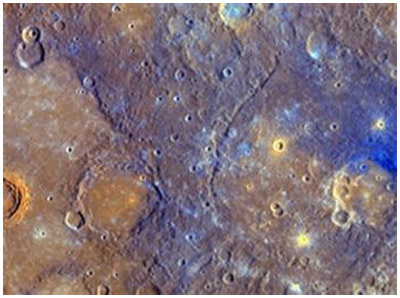The 'dead planet' used to be a giant fire cauldron
Although it is considered geologically dead planet, Mercury was very excited by the activity of numerous volcanoes on the surface a few billion years ago.
The latest images of the Messenger probe, published on October 29, help put an end to the long-standing debate from the 1970s on the role of volcanoes in Mercury's history.
Messenger flying in orbit Mercury took pictures on October 6, when the planet was closest to the Sun. The photos show giant lava flows on the " dead planet " surface, including hard lava blocks at a depth of more than 1,600 meters and craters of nearly 100 km in diameter.
Messenger also found a giant fold of about 300 meters high formed by the shrinking phenomenon of Glass when its surface cooled. This fold is nearly twice as high as the fold on the surface of Mars, said Maria Zuber, an expert at the Massachusetts Institute of Technology.

A picture of Mercury's surface was taken by the Messenger ship.(Photo: AP)
Combined with images captured by Messenger on January 14, 2008, scientists believe Mercury was once submerged in lava and dust because of the activity of thousands of volcanoes across the planet .
' Photos show that volcanoes play a very important role in Mercury's history. Their mass eruption may have occurred from 3.8 to 4 billion years ago. Mercury and the rest of the solar system were formed about 4.5 billion years ago , "said Mark Robinson, astronomer at the University of Arizona (USA).
Messenger has mapped about 30% of Sao Thuy's surface that people have never seen from a spaceship. Up to now, 95% of the planet's surface has been mapped.
Since the International Astronomical Society considers Pluto as a dwarf planet, Mercury has become the smallest planet in our solar system, about the size of a third of the Earth and slightly larger than the Moon.
- Evidence that Mercury is not a dead planet
- The sad truth about the eternal fire pit
- Fluttering of cauldron weighs 110kg
- The signal emitted from the dead planet shows the dark future of the Earth
- Dance of the dead planet signals life
- The mystery of the dead galaxies
- Giant ring of fire in the sky
- Mercury is not a dead planet
- Dead planets may be signaling in outer space
- Discover the giant planet with weird orbits
- The process of forming giant planets in the universe
- High-altitude fire hoses of nearly 600m sweep through the American town
 Van Allen's belt and evidence that the Apollo 11 mission to the Moon was myth
Van Allen's belt and evidence that the Apollo 11 mission to the Moon was myth The levels of civilization in the universe (Kardashev scale)
The levels of civilization in the universe (Kardashev scale) Today Mars, the sun and the Earth are aligned
Today Mars, the sun and the Earth are aligned The Amazon owner announced a secret plan to build a space base for thousands of people
The Amazon owner announced a secret plan to build a space base for thousands of people